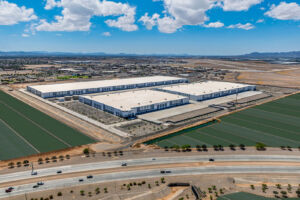Strategic investments by both the public and private sectors over the years has proven to be successful in creating new jobs and innovations, producing meaningful and lasting economic development impacts that will span generations.
For instance, a $500 million strategic investment in 2003 by the state for university infrastructure began an era of industry growth that has reportedly resulted in a 7:1 return on investment or $3.5 billion. In turn, Arizona’s Bioscience Industry increased its number of jobs in bioscience related fields by 49 percent, which is nearly four times the national average.

Arizona Governor Doug Ducey aims to build on that success after signing a landmark $1 billion investment plan in May to accommodate the growing long-term needs of Arizona’s higher education system in order to best serve future generations and provide the workforce of tomorrow.
The goal is to make sure Arizona’s public universities — Arizona State University, Northern Arizona University and The University of Arizona — have research and education facilities that can launch new discovery, attract new investment and educate students in new ways with more modern technology, says Arizona Board of Regents President Eileen Klein.
She thinks it signals that Arizona is really investing in its public higher education system in ways that are going to reaffirm real benefits to Arizona and Arizona businesses, which opens the door for greater investment from the private sector moving forward.
“Time and again, CEOs have selected Arizona for new business locations or expansions because they want to be close to places where new talents and discoveries are being developed,” Klein explains. “We see this as a real way to have our state’s universities be real attractants for further investment.”
Gov. Ducey’s University Capital Investment Program doubles down on the $500 million investment for universities from 2003. As one of only six states that require public universities to pay state sales tax, the program authorizes the universities to apply the state sales tax that each created for as much as $1 billion in bonding for research and development, infrastructure and deferred maintenance projects.
The new $1 billion investment plan was largely modeled after the $500 million investment from 2003. That plan enabled ASU to build the Biodesign Institute in 2003, which is a series of award winning, LEED-certified buildings that total 350,000 square feet in Tempe.
In 2003, it represented Arizona’s single largest research infrastructure investment in the biosciences. In fact, the Biodesign Institute later
won Arizona’s “Excellence in Economic Development Award” in 2009 for its innovative contributions to the state’s economic growth. Throughout its first decade of operation, an ASU study reports, the Biodesign Institute delivered an economic impact of $1.5 billion.
Since then, additional investments into Arizona’s Biosciences Industry and its three public universities can be seen across Downtown Phoenix, which is home to the Phoenix Biomedical Campus, a 30-acre, city-owned medical and bioscience campus for all three universities that’s planned for more than six-million square feet of biomedical-related research, academic and clinic facilities.
Its overall economic impact in Downtown Phoenix for 2013 was nearly $1.3 billion, of which $961 million is attributed to the UA College of Medicine – Phoenix presence. Additionally, the academic medical center accounted for 9,355 direct and indirect jobs in 2013.
“People are attracted to places where a lot of activity is going on and you’re seeing a complete redevelopment of Downtown Phoenix because people want to be near the universities and the opportunities those provide,” says Klein. “It’s a great example of how bringing all of these forces together can create an opportunity for learning, research and discovery.”
CALCULATIONS OF POTENTIAL IMPACT
In regards to the latest $1 billion investment plan, projections estimate the short-term return over the construction phase in the first three years would yield $2.7 billion in economic impact and a 5:1 return in the first five to seven years following construction. Adding it up, that’s $7.7 billion of economic impact the first 10 years.
Plus, the long-term investment would enable the universities to achieve an increase in extramural research funding of an additional $1 billion dollars each year by 2020, which would include federal and private sector research investments.

In addition to making needed building repairs, the Arizona Board of Regents has set an aggressive goal of increasing research funding for Arizona’s public universities from $1.1 billion a year to $1.6 billion a year by 2025.
This funding comes into the universities from grant writing institutions, the federal government and industry, which won’t happen without continued investments into research buildings.
HOW IT WORKS
House Bill 2547 appropriates $27 million in ongoing investments for universities that will enable approximately $1 billion in bonding – all without raising taxes. That allocation will enable universities to sell about $1 billion in bonds for infrastructure improvements, pending approval of the proposed projects by ABOR.
Once approved, public-private partnerships will be used to plan, design and build the new facilities to accommodate expanding enrollments of the universities and provide research that contributes to our state’s economy and the well-being of citizens in Arizona and around the world.
Also known as a PPP, 3P or P3, public-private partnerships are long-term, cooperative agreements between two or more public and private sectors, which have historically been used for megaprojects like President Dwight Eisenhower’s System of Interstate and Defense Highways, a massive road-building project that began construction in the 1950s.
“It’s exciting to think about how these partnerships come together for the benefit of the economy, but in a way, that produces a real demonstrable return on investment for taxpayers in Arizona,” says Klein.
She predicts this model of public-private partnership will continue because the state cannot afford to independently underwrite all the needs of the universities.
“So, having these partnerships not only help us promote new infrastructure but it also helps us promote sponsored research projects or other ways in which we can more closely meet the needs of the Arizona community with specialized development projects that really help tackle some of the challenges that businesses have for R&D or developing new talent,” Klein explains.





